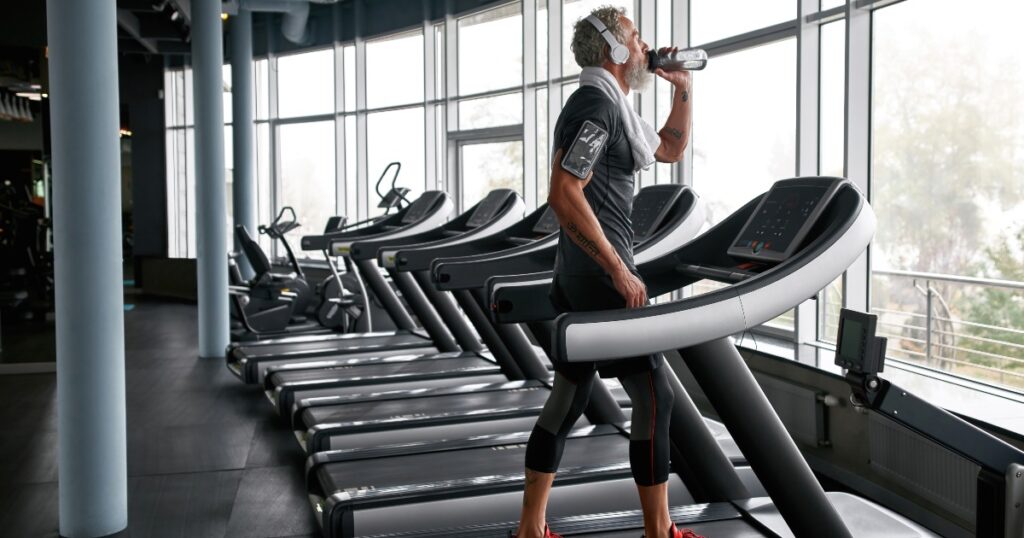10 Cardiovascular Endurance Exercises for a Healthier Heart
Exercise is important for good health. Cardiovascular endurance exercises can provide several cardiac health benefits. The heart is muscular, so it can make it stronger and also reduce the risk of heart disease.
Cardiovascular exercise comes in several forms, so anyone can find a type they enjoy. If you have a high risk of cardiovascular disease, you can’t go wrong with cardio exercise.
This article will talk about this in detail, so let’s get right into it.

Master your heart health now
Take part in our 60sec quiz and get a heart health plan tailored just for you.
Contents
How Are Cardiovascular Exercises Different Than Other Forms of Training?
Cardiovascular exercise is any physical activity that aims to increase how fast your heart pumps and how fast you breathe. It is also called aerobic or (cardiovascular) endurance exercise.
It is a form of heart-healthy exercise that can improve cardiovascular endurance.
It is important to distinguish cardiovascular exercise from resistance training (also known as weight or strength training). Resistance training primarily focuses on moving muscles against resistance, or weights, to make them stronger and improve muscular endurance.
Meanwhile, cardiovascular endurance exercises go for quick, repeated movements that get the heart and lungs going, and over time, this makes them stronger and more capable.
Start managing your heart health now!
Find out what works for you with this 60sec quiz.

Benefits of Cardiovascular Endurance

There are several perks that regular cardiovascular exercise can provide. Let’s talk about them.
- Reduces the risk of cardiovascular disease. A cardiovascular endurance exercise program aims to improve the strength of your cardiovascular system. This can directly reduce the risk of development of and death from heart disease.
- Improves lung capacity and the body’s oxygen efficiency. Exercise increases the oxygen demand in the muscles. This is why you start breathing a lot faster – to bring in more oxygen. The more you exercise, the more efficient your body’s respiration becomes.
- Improves physical ability and stamina. The boost that regular cardio endurance exercises can bring to your cardiorespiratory fitness improves your overall physical capabilities. You’ll find that you can stay active for longer without feeling fatigued.
- Can benefit mental health and sleep. While there are pharmaceutical options available, simply doing more physical activity is shown to be an effective option to improve your sleep quality and mental health.
Types of Cardio Exercise
There are different kinds of cardio exercises that you can tap into to improve your cardiovascular fitness. The common factor between them is that they all focus on continuous, rhythmic motions to get the heart and lungs going.
If you’re aiming for improved cardiovascular endurance, you are very likely to find a form of cardio that you enjoy.
Low-intensity cardio workouts
Low-intensity aerobic exercise is perfect for building cardiovascular endurance among beginners or people who have health conditions that stop them from engaging in more vigorous exercise.
Examples include:
- Swimming
- Cycling
- Walking
- Light jogging
- Rowing
High-intensity interval training (HIIT)

High-intensity interval training (HIIT) is great for cardiovascular endurance. It is best for people who work out regularly and are ready for more advanced exercise.
It involves short bouts of very intense exercise followed by brief periods of lower-intensity movement (or rest) and then another short round of intense activity; it continues until exhaustion.
The intensity of HIIT can push your heart to as high as 85% of its maximum heart rate. Not only does this lead to improved heart health, but it helps build cardiovascular endurance.
There are quite a few ways that you can incorporate HIIT into your exercise session:
- Sprinting for 30 seconds, followed by 15 seconds of walking
- Doing push-ups for 30 seconds, followed by 15 seconds of slow marching on a spot
- Squats or squat jumps for 30 seconds, followed by 15 seconds of slow marching on a spot
Sprint interval training (SIT)
Sprint interval training (SIT) taps into the potency of sprinting to improve cardiovascular health. This program alternates sprinting variable distances with rest periods.
A session of SIT was shown to improve cardiometabolic indices similar to 5 times as much traditional endurance exercise.
These exercises are pretty straightforward. For example, you can do the following:
- 150-meter sprint followed by 6 minutes of rest. Five reps of that.
- A 30-second sprint at top speed followed by 5 minutes of rest. Three or four reps of that.
However, if jogging for a few minutes wears you out, you might want to hold off on SIT until your cardiovascular endurance improves.
Bodyweight exercises
Exercises that use your own body weight as the only form of resistance create a balance between cardio and strength training. These exercises are great because most can be done right in your bedroom.
Doing the right exercises can engage muscles in your upper body or lower body and still get your heart pumping. Some exercises you can try include:
- Air squats
- Squat jumps
- Mountain climbers
- Push-ups
Other cardiovascular endurance exercises
You can improve your cardiovascular endurance with activities that might not seem like exercise at first glance. For instance, you can have fun while skiing or playing sports like tennis, basketball, or soccer, and you’ll still get your blood flow and breathing up.
Start managing your heart health now!
Find out what works for you with this 60sec quiz.

5 Examples of Cardio Exercises That Can Be Done at Home
Let’s cover a few cardiovascular exercises that you’ll be able to do right from the convenience of your home.
Jumping jacks
Jumping jacks are an easy cardio routine that can get your heart rate up and more oxygen into your lungs.
- Stand with your feet hip-width apart and your arms at rest.
- With your knees slightly bent, jump up.
- Spread your legs so you land with them shoulder-width apart. Your arms should be stretched over your head too.
- Jump back into the starting position.
- Aim for a total of 10 minutes daily.
Burpees
Burpees are a tough exercise, but as you increase intensity level when it comes to cardio, you get your heart rate up more effectively.
- Stand in place with your feet hip-width apart.
- Descend into a squat until your hands are on the floor.
- With your hands planted, jump backward into a push-up pose. Your body should be straight.
- Jump forward to have your feet back at the starting point.
- Stand up and raise your hands.
- Do at least 10 reps for a good set.
Jumping rope

With a skipping rope, you can build endurance pretty easily. It’s also very easy to go at your own pace with this.
- Stand in place with a skipping rope handle in each hand.
- Make sure the rope rests on the floor behind your heels.
- Rotating your wrists and forearms, bring the rope from behind, over your head, toward your toes.
- Jump and let it sweep under you.
- Continue this motion for about 50 reps in a set.
Stationary jogging
Jogging is a great exercise, and by staying in a spot, you can get the benefits indoors.
- Stand in a spot and alternate between lifting the knee of your left leg and then your right leg. Swing your arms as you do so.
- Increase the pace gradually.
- As you do, bring the heel of one foot that is raised closer to your buttocks.
- Continue the jog as long as you can.
Dancing
You might not realize it, but dancing is a fantastic cardiovascular exercise. Simply put on music that you enjoy and begin to move to get your heart rate going! Dance however you feel like!
5 Examples of Cardio Exercises That Can Be Done in the Gym
If increasing your cardiovascular endurance is important to you, the gym is the best place to do it, thanks to equipment that makes cardio easier.
Elliptical machine
The elliptical is an intuitive machine for getting your heart rate going. Step onto it with your feet flat on the pedals.
Push each pedal forward and alternate. As your right foot goes forward, the left should be moving backward with its pedal, and vice-versa. As this happens, hold onto the handles and move your arms naturally with their motion.
Rowing machine
The rowing machine is not only great for pushing your heart rate up but also engages your core muscles nicely.
An easy way to learn this machine is to split it into lower and upper body motions. Strap your feet in and take a seat.
- Hold the bar with your arms outstretched and your knees bent. Keep your back straight and extend your legs to push back. This is the lower-body motion.
- From a position with your legs extended, hold the bar with your arms stretched. Pull the bar toward your chest with your elbows pointing outward. Your back muscles should be doing the pulling.
- Now, put these two motions together for a complete row. The upper motion should start after completing the leg extension.
Stair climber
There’s very little to be said about how to use the stair climber machine. You climb it just like you would a regular staircase! Just aim to keep your back straight and not hunched as you do so.
Treadmill

The treadmill is one of the best cardio machines. There’s no special knowledge needed to use it. Just get on it and either walk briskly, jog or run – whichever intensity is best for you. This is a great way to boost aerobic capacity and heart rate.
Exercise bike
Even if you can’t actually ride a bike, an exercise (or stationary) bike can give you similar benefits to cycling.
Sit on the bike with your feet on the pedals and your hands on the handles. Pump your legs in a circular motion to move the pedals smoothly. You can adjust the resistance for more of a challenge.
Measuring Cardiovascular Endurance

You can measure your cardiovascular endurance by yourself by walking or running a set distance, such as a mile, and monitoring the time that it takes. You can easily track your progress this way, as progressively quicker times mean better endurance.
However, the gold standard is using VO2 Max, which refers to your maximum oxygen consumption during exercise. With a few basic variables and the time it takes you to walk a mile, you can use an online calculator to see what your endurance rates are.
Regardless of which you use, it is important to keep track of these indices to help you improve your fitness level over time. After all, the better your cardio endurance, the less the risk of heart disease.
An app like Cardi Health can help make that happen, especially as it can help you track your heart rate and also give you a personalized fitness plan to help you stay fit and build your endurance.
Duration and Frequency of Cardiovascular Exercise
Not everyone can exercise at the same intensity. People who are younger or who exercise regularly can handle high-intensity sessions, but people who are older or just starting out usually can’t.
While you should aim for at least 150 minutes of moderate-intensity aerobic exercise each week, you might need to start lower than that if it is too harsh on you. For high-intensity activity, 75 minutes a week might be enough.
Role of Consistency and Progression

Cardiovascular exercise can lead to a reduced risk of heart disease and allow your body to use oxygen efficiently. However, to really reap these benefits, it is important that you stay consistent.
Not only do you need to make sure you keep exercising regularly, but it is also important to continually build intensity. In strength training, this is called progressive overload, but it applies to building cardiovascular endurance too.
Equipping yourself with a well-designed workout plan can make consistency and progression easy guidelines to stick by. The good thing is that you don’t need to worry too much about putting together your own plan when Cardi Health can do that for you.
FAQ
There are some things you might be curious about when it comes to cardiovascular endurance programs, so let’s address some of them.
How long before I see improvements?
With any form of exercise, patience is key. However, with about 90 minutes of training each week, you might start to notice improved endurance within two months.
What exercises should I do as a beginner?
As a beginner, the best exercises are the ones that take it easy on your body but that you also enjoy doing. Jumping jacks, jogging, and running, are great places to start.
What’s the importance of monitoring my heart rate?
As your heart gets stronger, your resting heart rate drops. This is because your body gets more efficient at pumping blood and utilizing the oxygen-carrying blood that each pump delivers. Keeping track of your heart rate at rest and after working out might be the quickest way to track your progress.
Start managing your heart health now!
Find out what works for you with this 60sec quiz.

Key Takeaways
Building up your cardiovascular endurance is one sign that you’re building up a healthier heart, and this can reduce your risk of cardiovascular disease. At the same time, it can also lead to improved sleep quality, better mental health, and overall better fitness.
You should aim to have a variety of cardiovascular endurance workouts in your daily routine to promote a stronger heart and a healthier life.
Related articles
Best Foods to Lower Cholesterol
Does Caffeine Raise Blood Pressure?
Does Drinking Water Lower Blood Pressure?
Causes of High Blood Pressure at Night
10 DASH Diet Breakfasts for a Healthy Start
Heart-Healthy Diet Guide
What Should an 85-Year-Old Blood Pressure Be?
What is Normal Blood Pressure for a 70-Year-Old?
How to Read Blood Pressure: A Comprehensive Guide
Manage your heart health now
Find out what works best for you with this 60sec quiz and get your personalized heart health plan.

